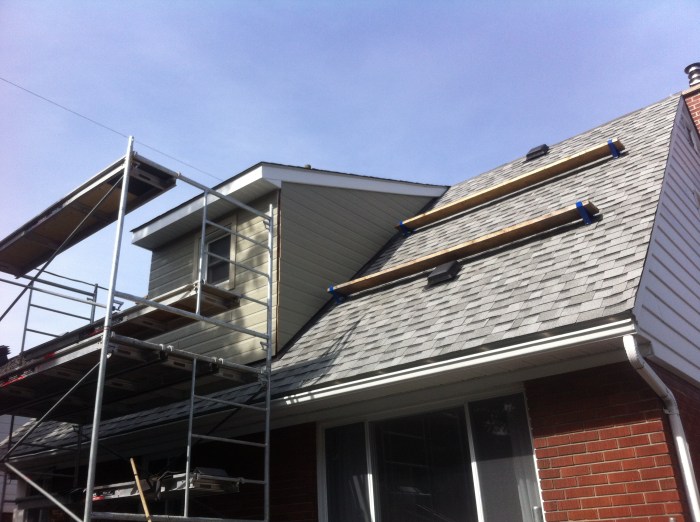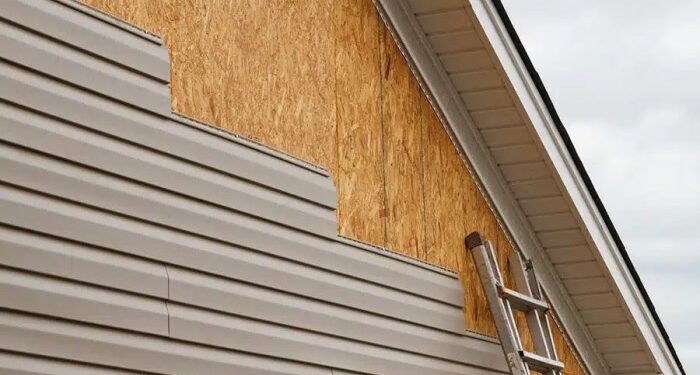Delving into siding on the roof, this introduction immerses readers in a unique and compelling narrative. From the different materials used to the installation process and maintenance, this topic covers all aspects of roof siding in a detailed yet accessible manner.
As we delve deeper into the world of roof siding, readers will gain valuable insights into the various types of materials, installation techniques, and maintenance tips that are essential for ensuring the longevity and efficiency of roof siding.
Types of Roof Siding
When it comes to roof siding, there are various materials to choose from, each with its own set of advantages and disadvantages. Let's take a closer look at the different types of roof siding materials.
Metal Siding
Metal siding, like aluminum or steel, is a popular choice for roofs due to its durability and longevity. It is resistant to fire, rot, and insects, making it a low-maintenance option for homeowners. However, metal siding can be prone to dents and scratches, especially in areas prone to severe weather conditions like hailstorms.
Vinyl Siding
Vinyl siding is another common choice for roof materials. It is affordable, easy to install, and comes in a wide range of colors and styles. Vinyl siding is also low maintenance and resistant to rot and pests. However, it may not be as durable as metal siding and can crack or fade over time, especially in extreme temperatures.
Comparison of Durability
- Metal siding is generally more durable than vinyl siding, with a longer lifespan and better resistance to weather damage.
- Vinyl siding, while less durable, is still a cost-effective option that can provide adequate protection for your roof.
Installation Process

Installing siding on a roof can be a complex process that requires attention to detail and precision. Here is a step-by-step guide to help you through the installation process.
Preparing the Roof
- Clean the roof surface thoroughly to remove any dirt, debris, or old siding.
- Inspect the roof for any damage or leaks that need to be repaired before installing new siding.
- Ensure the roof is dry and free of moisture before starting the installation.
Aligning the Siding
- Start by measuring and marking the placement of the siding on the roof to ensure proper alignment.
- Use a chalk line to create guidelines for where each piece of siding should be placed.
- Double-check the alignment before securing the siding in place to avoid any mistakes.
Weatherproofing
- Apply a weatherproof barrier, such as a moisture barrier or underlayment, before installing the siding to protect the roof from water damage.
- Ensure all seams and joints are properly sealed to prevent leaks and drafts.
- Use flashing and caulking to seal any gaps between the siding and other roofing components.
Tools Required
- Hammer
- Nails or screws
- Tape measure
- Chalk line
- Saw (for cutting siding to size)
- Level
- Weatherproof barrier
- Flashing
- Caulking gun
Maintenance and Repair

Regular maintenance is essential to ensure the longevity and performance of roof siding
Maintenance Tasks
- Inspect for any signs of damage, such as cracks, holes, or warping.
- Clean the siding regularly to remove dirt, debris, and mold buildup.
- Trim any overhanging branches or vegetation that may be touching the siding.
- Check for loose or missing fasteners and replace them as needed.
- Repaint or reseal the siding every few years to maintain its protective coating.
Identifying Issues and Repairing
- Common issues with roof siding include water damage, mold growth, and pest infestations.
- If you notice any of these issues, it is crucial to address them promptly to prevent further damage.
- Minor damages, such as small cracks or dents, can often be repaired with simple DIY techniques.
DIY Repair Techniques
- Use a caulking gun to fill in small cracks or holes in the siding.
- Replace damaged or missing shingles or panels with new ones.
- Apply a fresh coat of paint or sealant to protect the siding from the elements.
- For mold or mildew growth, scrub the affected area with a mixture of water and bleach.
Energy Efficiency and Insulation
When it comes to the energy efficiency of a building, the choice of roof siding material plays a crucial role. Different materials have varying impacts on how well a property retains heat or cool air, ultimately affecting energy consumption.
Impact of Siding Materials
- Vinyl siding: While lightweight and affordable, vinyl siding offers limited insulation properties compared to other materials.
- Fiber cement siding: Known for its durability, fiber cement siding provides better insulation, helping to regulate indoor temperatures more effectively.
- Wood siding: Natural wood siding offers good insulation but may require regular maintenance to ensure optimal performance.
- Insulated siding: Specifically designed for improved energy efficiency, insulated siding reduces heat loss and can lower energy bills.
Role of Siding in Insulation
Roof siding acts as a protective barrier against the elements, helping to prevent heat transfer between the interior and exterior of a property. By enhancing insulation, siding can reduce the need for excessive heating or cooling, leading to lower energy consumption.
Eco-Friendly Siding Options
- Sustainable wood siding: Made from renewable sources, sustainable wood siding is environmentally friendly and provides natural insulation properties.
- Recycled metal siding: Utilizing recycled materials, metal siding is durable and energy-efficient, making it a sustainable choice for eco-conscious homeowners.
- Composite siding: Combining recycled wood fibers and plastics, composite siding offers excellent insulation and is resistant to rot and pests, contributing to energy efficiency.
Last Recap
In conclusion, siding on the roof plays a crucial role not just in the aesthetics of a building but also in its functionality and energy efficiency. By understanding the nuances of different siding materials and installation processes, homeowners can make informed decisions to enhance the durability and sustainability of their roofs.
FAQs
What are the common types of roof siding materials used?
Common roof siding materials include metal, vinyl, wood, and fiber cement. Each material has its own advantages and disadvantages based on factors like cost, durability, and maintenance requirements.
How can I identify issues with roof siding that require repair or replacement?
Look out for signs such as warping, cracking, or mold growth on the siding. If you notice any of these issues, it's advisable to consult a professional to assess whether repair or replacement is necessary.
Are there any eco-friendly siding options available for roofs?
Yes, eco-friendly siding options such as recycled vinyl or fiber cement siding are available, which not only enhance energy efficiency but also contribute to sustainable building practices.














